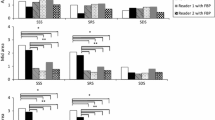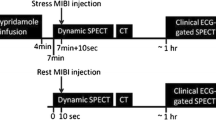Abstract
Purpose
There is proven evidence for the importance of myocardial perfusion-single-photon emission computed tomography (SPECT) with computerised determination of summed stress and rest scores (SSS/SRS) for the diagnosis of coronary artery disease (CAD). SSS and SRS can thereby be calculated semi-quantitatively using a 20-segment model by comparing tracer-uptake with values from normal databases (NDB). Four severity-degrees for SSS and SRS are normally used: <4, 4–8, 9–13, and ≥14. Manufacturers’ NDBs (M-NDBs) often do not fit the institutional (I) settings. Therefore, this study compared SSS and SRS obtained with the algorithms Quantitative Perfusion SPECT (QPS) and 4D-MSPECT using M-NDB and I-NDB.
Methods
I-NDBs were obtained using QPS and 4D-MSPECT from exercise stress data (450 MBq 99mTc-tetrofosmin, triple-head-camera, 30 s/view, 20 views/head) from 36 men with a low post-stress test CAD probability and visually normal SPECT findings. Patient group was 60 men showing the entire CAD-spectrum referred for routine perfusion-SPECT. Stress/rest results of automatic quantification of the 60 patients were compared to M-NDB and I-NDB. After reclassifying SSS/SRS into the four severity degrees, kappa (κ) values were calculated to objectify agreement.
Results
Mean values (vs M-NDB) were 9.4 ± 10.3 (SSS) and 5.8 ± 9.7 (SRS) for QPS and 8.2 ± 8.7 (SSS) and 6.2 ± 7.8 (SRS) for 4D-MSPECT. Thirty seven of sixty SSS classifications (κ = 0.462) and 40/60 SRS classifications (κ = 0.457) agreed. Compared to I-NDB, mean values were 10.2 ± 11.6 (SSS) and 6.5 ± 10.4 (SRS) for QPS and 9.2 ± 9.3 (SSS) and 7.2 ± 8.6 (SRS) for 4D-MSPECT. Forty four of sixty patients agreed in SSS and SRS (κ = 0.621 resp. 0.58).
Conclusion
Considerable differences between SSS/SRS obtained with QPS and 4D-MSPECT were found when using M-NDB. Even using identical patients and identical I-NDB, the algorithms still gave substantial different results.


Similar content being viewed by others

References
Berman DS, Kiat H, Van Train T, Garcia E, Friedman J, Maddahi J. Technetium 99m sestamibi in the assessment of chronic coronary artery disease. Semin Nucl Med 1991;21:190–212.
Hachamovitch R, Berman DS, Kiat H, Cohen I, Cabico JA, Wang FP, et al. Effective risk stratification using exercise myocardial perfusion SPECT in women: gender-related differences in prognostic nuclear testing. J Am Coll Cardiol 1996;28:34–44.
Klocke FJ, Baird MG, Lorell BH, Bateman TM, Messer JV, Berman DS, et al. ACC/AHA/ASNC guidelines for the clinical use of cardiac radionuclide imaging-executive summary: a report of the American College of Cardiology/American Heart Association Task Force on Practice Guidelines (ACC/AHA/ASCN Committee to Revise the 1995 Guidelines for the Clinical Use of Cardiac Radionuclide Imaging). Circulation 2003;108:1404–18.
Berman DS, Kiat H, Friedman JD, Wang FP, van Train K, Matzer L, et al. Separate acquisition rest thallium-201/stress technetium-99m sestamibi dual-isotope myocardial perfusion single-photon emission computed tomography: a clinical validation study. J Am Coll Cardiol 1993;22:1455–64.
Metz LD, Beattie M, Hom R, Redberg RF, Grady D, Fleischmann KE. The prognostic value of normal exercise myocardial perfusion imaging and exercise echocardiography: a meta-analysis. J Am Coll Cardiol 2007;49:227–37.
Elhendy A, Schinkel AF, van Domburg RT, Bax JJ, Valkema R, Huurman A, et al. Prognostic value of exercise stress technetium-99m-tetrofosmin myocardial perfusion imaging in patients with normal baseline electrocardiograms. Am J Cardiol 2006;98:585–90.
Hachamovitch R, Berman DS, Kiat H, Cohen I, Cabico JA, Friedman J, et al. Exercise myocardial perfusion SPECT in patients without known coronary artery disease: incremental prognostic value and use in risk stratification. Circulation 1996;93:905–14.
Hachamovitch R, Berman DS, Shaw LJ, Kiat H, Cohen I, Cabico JA, et al. Incremental prognostic value of myocardial perfusion single photon emission computed tomography for the prediction of cardiac death: differential stratification for risk of cardiac death and myocardial infarction. Circulation 1998;97:535–43.
Berman DS, Hachamovitch R, Kiat H, Cohen I, Cabico JA, Wang FP, et al. Incremental value of prognostic testing in patients with known or suspected ischemic heart disease: a basis for optimal utilization of exercise technetium-99m sestamibi myocardial perfusion single-photon emission computed tomography. J Am Coll Cardiol 1995;26:639–47.
Schaefer WM, Lipke CS, Standke D, Kuhl HP, Nowak B, Kaiser HJ, et al. Quantification of left ventricular volumes and ejection fraction from gated 99mTc-MIBI SPECT: MRI validation and comparison of the Emory Cardiac Tool Box with QGS and 4D-MSPECT. J Nucl Med 2005;46:1256–63.
Bermann DS, Xingping K, Nishina H, Slomka PJ, Shaw LJ, Hayes SW, et al. Diagnostic accuracy of gated Tc-99m sestamibi stress myocardial perfusion SPECT with combined supine and prone acquisitions to detect coronary artery disease in obese and nonobese patients. J Nucl Cardiol 2006;13:191–201.
Sharir T, Xingping K, Germano G, Bax JJ, Shaw Lj, Gransar H, et al. Prognostic value of poststress left ventricular volume and ejection fraction by gated myocardial perfusion SPECT in women and men: gender-related differences in normal limits and outcomes. J Nucl Cardiol 2006;13:495–506.
Lima RS, De Lorenzo A, Soares AJ. Relation between postexercise abnormal heart rate recovery and myocardial damage evidenced by gated single-photon emission computed tomography. Am J Cardiol 2006;97:1452–4.
Mazzanti M, Germano G, Kiat H, Kavanagh PB, Alexanderson E, Friedman JD, et al. Identification of severe and extensive coronary artery disease by automatic measurement of transient ischemic dilation of the left ventricle in dual-isotope myocardial perfusion SPECT. J Am Coll Cardiol 1996;27:1612–20.
Svensson A, Akesson L, Edenbrandt L. Quantification of myocardial perfusion defects using three different software packages. Eur J Nucl Med Mol Imaging 2004;31:229–32.
Diamond GA, Forrester JS. Analysis of probability as an aid in the clinical diagnosis of coronary-artery disease. N Engl J Med 1979;300:1350–8.
Bland JM, Altman DG. Statistical methods for assessing agreement between two methods of clinical measurement. Lancet 1986;1:307–10.
Acknowledgements
Thanks are due to Norbert Franke and Carsten Ponath from Siemens Germany for the unrestricted relinquishment of an e.soft workstation running the QPS licence and Alejandro Rodón for general and language editing.
Author information
Authors and Affiliations
Corresponding author
Rights and permissions
About this article
Cite this article
Knollmann, D., Knebel, I., Koch, KC. et al. Comparison of SSS and SRS calculated from normal databases provided by QPS and 4D-MSPECT manufacturers and from identical institutional normals. Eur J Nucl Med Mol Imaging 35, 311–318 (2008). https://doi.org/10.1007/s00259-007-0600-5
Received:
Accepted:
Published:
Issue Date:
DOI: https://doi.org/10.1007/s00259-007-0600-5



